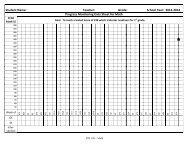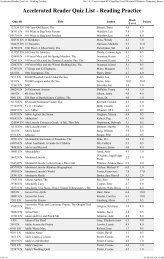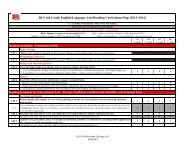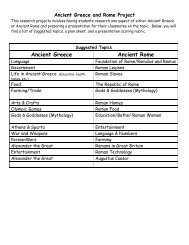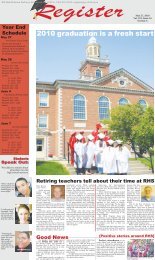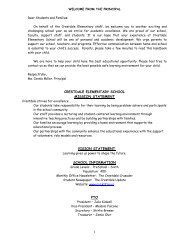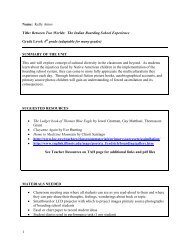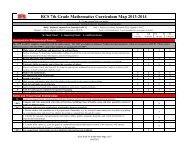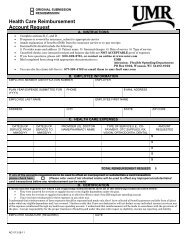2013-2014 Math Grade 2.pdf
2013-2014 Math Grade 2.pdf
2013-2014 Math Grade 2.pdf
You also want an ePaper? Increase the reach of your titles
YUMPU automatically turns print PDFs into web optimized ePapers that Google loves.
RCS 2nd <strong>Grade</strong> <strong>Math</strong>ematics Curriculum Map <strong>2013</strong>-<strong>2014</strong>X = COVERED IN ENVISION MATH THIS SIX WEEKSTESTED ON ACUITY DIAGNOSTIC ASSESSMENTenVision Topic Sequence 1, 2,3 4, 5, 6 7, 8, 9 10, 11 12, 13, 1415, 16 &Step UpStandards for <strong>Math</strong>ematical Practice1 Make sense of problems and persevere in solving them. X X X X X X2 Reason abstractly and quantitatively. X X X X X X3 Construct viable arguments and critique the reasoning of others. X X X X X X4 Model with mathematics. X X X X X X5 Use appropriate tools strategically. X X X X X X6 Attend to precision. X X X X X X7 Look for and make use of structure. X X X X X X8 Look for and express regularity in repeated reasoning. X X X X X XOperations and Algebraic ThinkingRepresent and solve problems involving addition and subtraction.2.OA.1Use addition and subtraction within 100 to solve one- and two-step word problems involving situations of adding to, takingfrom, putting together, taking apart, and comparing, with unknowns in all positions.X X X2.OA.2Add and subtract within 20.Fluently add and subtract within 20 using mental strategies.2 By end of <strong>Grade</strong> 2, know from memory sums all of two one-digitnumbers.X2.OA.3Work with equal groups of objects to gain foundations for multiplication.Determine whether a group of objects (up to 20) has an odd or even number of members, e.g., by pairing objects or countingthem by 2s; write an equation to express an even number as a sum of two equal addends.X2.OA.4Use addition to find the total number of objects arranged in rectangular arrays with up to 5 rows and up to 5 columns; write anequation to express the total as a sum of equal addends.XNumber and Operations in Base TenUnderstand place value.Understand that the three digits of a three-digit number represent amounts of hundreds, tens, and ones; e.g., 706 equals 72.NBT.1hundreds, 0 tens, and 6 ones. Understand the following as special cases:XXa. 100 can be thought of as a bundle of ten tens - called a "hundred." X Xb. The numbers 100, 200, 300, 400, 500, 600, 700, 800, 900 refer to one, two, three, four, five, six, seven, eight, or ninehundreds (and 0 tens and 0 ones).X2.NBT.2 Count within 1000; skip-count by 5s, 10s, and 100s. X X2.NBT.3 Read and write numbers to 1000 using base-ten numerals, number names, and expanded form. X XCompare two three-digit numbers based on meanings of the hundreds, tens, and ones digits, using >, =, and < symbols to2.NBT.4record the results of comparisons.XXUse place value understanding and properties of operations to add and subtract.1st6 weeks2nd6 Weeks3rd6 Weeks4th6 Weeks5th6 Weeks6th6 Weeks<strong>2013</strong>-<strong>2014</strong> 2nd <strong>Grade</strong> <strong>Math</strong> Page 1 of 28/6/<strong>2013</strong>
Fluently add and subtract within 100 using strategies based on place value, properties of operations, and/or the relationship2.NBT.5between addition and subtraction.X X X X2.NBT.6 Add up to four two-digit numbers using strategies based on place value and properties of operations. X XAdd and subtract within 1000, using concrete models or drawings and strategies based on place value, properties of2.NBT.7operations, and/or the relationship between addition and subtraction; relate the strategy to a written method. Understand thatin adding or subtracting three-digit numbers, one adds or subtracts hundreds and hundreds, tens and tens, ones and ones; andX Xsometimes it is necessary to compose or decompose tens or hundreds.2.NBT.8 Mentally add 10 or 100 to a given number 100-900, and mentally subtract 10 or 100 from a given number 100-900. X X X2.NBT.9 Explain why addition and subtraction strategies work, using place value and the properties of operations. X X X X XMeasurement and DataMeasure and estimate lengths in standard units.2.MD.1Measure the length of an object by selecting and using appropriate tools such as rulers, yardsticks, meter sticks, andmeasuring tapes.X2.MD.2Measure the length of an object twice, using length units of different lengths for the two measurements; describe how the twomeasurements relate to the size of the unit chosen.X2.MD.3 Estimate lengths using units of inches, feet, centimeters, and meters. X2.MD.4Measure to determine how much longer one object is than another, expressing the length difference in terms of a standardlength unit.XRelate addition and subtraction to length.2.MD.5Use addition and subtraction within 100 to solve word problems involving lengths that are given in the same units, e.g., byusing drawings and equations with a symbol for the unknown number to represent the problem.X2.MD.6Represent whole numbers as lengths from 0 on a number line diagram with equally spaced points corresponding to thenumbers 0, 1, 2,..., and represent whole-number sums and differences within 100 on a number line diagram.XWork with money and time.2.MD.7 Tell and write time from analog and digital clocks to the nearest five minutes, using a.m. and p.m.2.MD.8 Solve word problems involving dollar bills, quarters, dimes, nickels, and pennies, using $ and ¢ symbols appropriately. XRepresent and interpret data.2.MD.9Generate measurement data by measuring lengths of several objects to the nearest whole unit, or by making repeatedmeasurements of the same object. Show the measurements by making a line plot, where the horizontal scale is marked off inwhole-number units.Draw a picture graph and a bar graph (with single-unit scale) to represent a data set with up to four categories. Solve simple2.MD.10put-together, take-apart, and compare problems using information presented in a bar graph.GeometryReason with shapes and their attributes.2.G.1Recognize and draw shapes having specified attributes, such as a given number of angles or a given number of equal faces.5Identify triangles, quadrilaterals, pentagons, hexagons, and cubes.X2.G.2 Partition a rectangle into rows and columns of same-size squares and count to find the total number of them. X2.G.3Partition circles and rectangles into two, three, or four equal shares, describe the shares using the words halves, thirds, half of,a third of, etc., and describe the whole as two halves, three thirds, four fourths. Recognize that equal shares of identical wholesneed not have the same shape.X<strong>2013</strong>-<strong>2014</strong> 2nd <strong>Grade</strong> <strong>Math</strong> Page 2 of 28/6/<strong>2013</strong>



